| Srl | Item |
| 1 |
ID:
130625
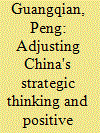

|
|
|
| 2 |
ID:
118607
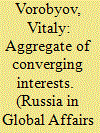

|
|
|
|
|
| Publication |
2012.
|
| Summary/Abstract |
As the center of gravity in global development shifts towards the Asia-Pacific region, the political significance of Central Asia as Eurasia's geopolitical core increases. China's rapidly evolving cooperation with this region becomes increasingly tight. But what interests lie behind this process? And how lasting can such cooperation be?
|
|
|
|
|
|
|
|
|
|
|
|
|
|
|
|
| 3 |
ID:
130523


|
|
|
| 4 |
ID:
078454
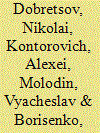

|
|
|
| 5 |
ID:
137286
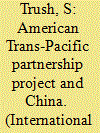

|
|
|
|
|
| Summary/Abstract |
THE TRANS-PACIFIC PARTNERSHIP (TPP) initiative was first launched by New Zealand, Singapore and Chile in 2003. Since the United States joined the process in 2011, this concept, significantly reformatted and with an expanded membership, has been regarded as a purely American one. It is also rightly seen as a (if not the) key element of the strategic shift of focus in U.S. foreign policy to the Asia-Pacific Region. It is also often viewed in conjunction with the conceptually symmetrical Transatlantic Partnership between the United States and the European Union. Many experts argue - with varying degrees of credibility - that the combination of these two initiatives is of central, systemic importance to the foreign-policy and foreign economic strategy of the Administration of Barack Obama.
|
|
|
|
|
|
|
|
|
|
|
|
|
|
|
|
| 6 |
ID:
130636
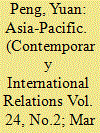

|
|
|
|
|
| Publication |
2014.
|
| Summary/Abstract |
The ability to build a new model of major-nation relations will hinge upon the long-term
peaceful cooperation between China and the United States. The author proposes a
roadmap to solve five problematic issues. All of these are essential for China and the U.S.
to co-exist peacefully and cooperate well in the Asia-Pacific region.
|
|
|
|
|
|
|
|
|
|
|
|
|
|
|
|
| 7 |
ID:
137356
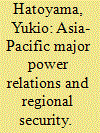

|
|
|
|
|
| Summary/Abstract |
I’m delighted once again that the 3rd World Peace Forum, under the leadership of President Tang Jiaxuan, is being held here at Tsinghua University. I would like to thank University president, Dr. Cheng Jining for granting me this opportunity to speak at this event for the third consecutive year. Last year, I was deeply honored to be awarded the title of Guest Professor. It is truly a great pleasure to return here to speak to you all once again, this time on the topic of Asia-Pacific Major Power Relations and Regional Security. When I was appointed Prime Minister of Japan in 2009 I published an essay in the magazine Voice. In the essay, I wrote the following passage: “As a result of the failure of the Iraq war and the financial crisis, the era of US globalism is coming to an end and … we are moving away from a unipolar world led by the US towards an era of multi-polarity.” I continued by writing “I believe that the East Asian region … must be recognized as Japan’s basic sphere of being.” In the five years since then, the political situation in Japan has changed considerably but my basic stance on this matter remains the same.
|
|
|
|
|
|
|
|
|
|
|
|
|
|
|
|
| 8 |
ID:
137357
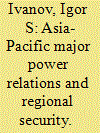

|
|
|
|
|
| Summary/Abstract |
Let me start my presentation with saying how privileged and honored I feel for having a chance to be here, at the Tsinghua University once again. Considering myself to be a veteran of the World Peace Forum, I have to say that over last years the Forum emerged as one of the most prestigious and representative meeting points for security related discussions in the Asia-Pacific region. In many ways, it is a unique opportunity for experts, educators, opinion makers and state officials of our large and diverse region to get together and to exchange views on critical issues of the past, present and future.
|
|
|
|
|
|
|
|
|
|
|
|
|
|
|
|
| 9 |
ID:
126866
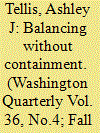

|
|
|
| 10 |
ID:
169676


|
|
|
| 11 |
ID:
130819
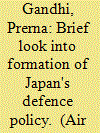

|
|
|
| 12 |
ID:
185485


|
|
|
| 13 |
ID:
120935
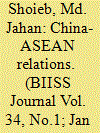

|
|
|
|
|
| Publication |
2013.
|
| Summary/Abstract |
Asia-Pacific region is an important part of the globe as competing interests of big powers often generate conflict to the ground. Over the past decade, the world has witnessed rapid development between Association of South East Asian Nations (ASEAN) and China. Historically China tries to maintain a very good relation with its neighbouring countries. When China was the middle kingdom in 1300A.D.-1900 A.D., it maintained a very close tie with its neighbours. China is rising again as a formidable global power; and its rise is one of the most critical developments in the contemporary world. In the eve of rising, China gives value to the relationship with the ASEAN. Since the beginning of ASEAN in 1967, China maintained relations with the regional association. However, it was the late 1980s that China started to intensify its efforts to establish diplomatic relations with ASEAN member states. In recent years, both are closer to each other than before. Even though, differences exist between the two; for example, the case of South China Sea. Their relations are more focused on economic cooperation; however, strategic partnerships continue. This paper studies phase-wise trends, and critical issues of ChinaASEAN relations.
|
|
|
|
|
|
|
|
|
|
|
|
|
|
|
|
| 14 |
ID:
116618


|
|
|
|
|
| Publication |
2012.
|
| Summary/Abstract |
The Trans-Pacific Partnership (TPP) is a multilateral free trade agreement (FTA) which aims to liberalize the economies of the Asia-Pacific region. The rapid movement of the TPP agenda, however, has caused China some disquiet. Originally, the agreement was signed among four countries (Brunei, Chile, New Zealand and Singapore) on June 3, 2005, and entered into force on May 28, 2006. In 2008, five additional countries (Australia, Malaysia, Peru, the United States, and Vietnam) began negotiations to join the group.1 On November 12, 2011, the leaders of these nine TPP partner countries announced the broad outlines of an expanded TPP: it will promote innovation, enhance economic growth and development, and support the creation and retention of jobs among the nine dynamic Asia-Pacific economies.2 Further negotiations are still underway, with Japan, Canada, and Mexico also having demonstrated a strong interest in joining.
|
|
|
|
|
|
|
|
|
|
|
|
|
|
|
|
| 15 |
ID:
126403


|
|
|
| 16 |
ID:
155017


|
|
|
|
|
| Summary/Abstract |
China’s expansionist and aggressive foreign policy based on its growing military power has worsened the prevailing tense scenario in the Asia– Pacific region. In response to Beijing’s seeming goal of establishing its hegemony, India has strengthened strategic relations with neighbours as well as further afield. Sudhanshu Tripathi avers that New Delhi now needs to evolve an institutional network of all Asian countries in the form of a regional bulwark of “Greater Asia” to consolidate its position.
|
|
|
|
|
|
|
|
|
|
|
|
|
|
|
|
| 17 |
ID:
111883
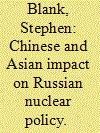

|
|
|
|
|
| Publication |
2012.
|
| Summary/Abstract |
Asia, where nuclear powers already interact (including North Korea), exerts a growing influence on the thinking and policy underlying Russia's current and future nuclear (and overall defense) posture. China's rise is forcing Russia into a greater reliance on strategic offensive weapons and tactical nuclear weapons. These in turn will reinforce its opposition to US missile defenses, not only in Europe but also in Asia. Russia must now entertain the possibility of nuclear use in regional conflicts that would otherwise remain purely conventional. It cannot be postulated blindly that nuclear weapons serve no discernible purpose other than to deter nuclear attacks by other nuclear powers. The strategic equation in Asia and in the Russian Far East convincingly demonstrates the falsity of this approach. Nuclear weapons will be the essential component of Russia's regional defense policy if not of its overall policies - and this also includes contingencies in Europe.
|
|
|
|
|
|
|
|
|
|
|
|
|
|
|
|
| 18 |
ID:
126398
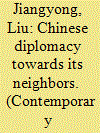

|
|
|
| 19 |
ID:
146491
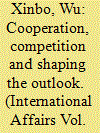

|
|
|
|
|
| Contents |
The United States has long maintained a significant political, economic and security presence in the Asia–Pacific region and has been a major factor shaping China's geopolitical and geo-economic environment. Over the last few years, China has demonstrably attached higher priority and devoted more resources to its neighbourhood diplomacy. This article examines the impact of the so-called ‘US factor’ on this recent shift in Beijing's international strategy under the new leadership of Xi Jinping. It looks at both cooperation/coordination and competition/conflict between China and the United States in a number of regional security issues in China's neighbourhood, such as in the Korean peninsula, Afghanistan and the South and East China Seas. It argues that it is principally the Obama administration's ‘rebalance to Asia’ strategy that has prompted China to take a number of initiatives to attend to its neighbourhood diplomacy. As Washington rebalances to Asia and Beijing rebalances to its neighbourhood, interactions between China and the US on China's periphery have intensified, which in turn has a significant impact on the configuration of China's neighbourhood diplomacy, as well as on the evolving regional order.
|
|
|
|
|
|
|
|
|
|
|
|
|
|
|
|
| 20 |
ID:
116051
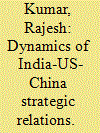

|
|
|